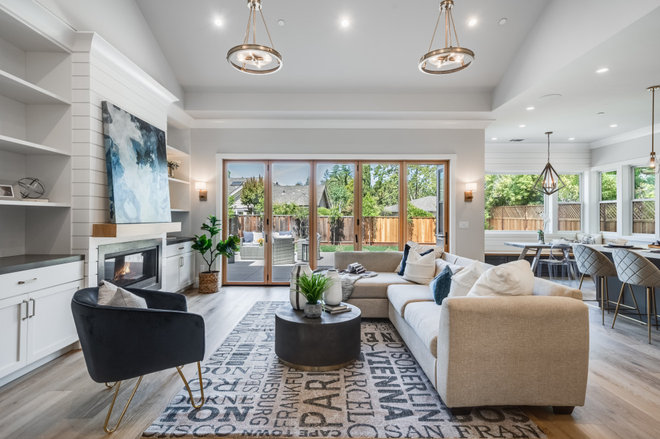


1. No Zoning
To be functional and visually appealing, an open-plan space needs to be zoned into separate spaces — for example, cooking, dining and relaxing areas. These zones essentially act as individual rooms within an open-plan space. At the same time, you want to have a sense of visual continuity among the zones, interior designer Kat Siketa says.
Often, she says, homeowners forget to include those essential anchor points that ground the individual areas within an open-plan space. As a result, an open-plan space can end up feeling like a giant hall.
Solution: A simple way to define the individual areas is to move the sofa across the room to split it in half, Siketa says. Adding a rug under the sofa and a floor lamp or table tamps beside the sofa will give more definition to the living zone. Then, if you can, create a sense of continuity among the kitchen, living and dining spaces by using the same flooring throughout.
Tip: Add interest to your open-plan scheme by incorporating vertical layers. The best way to do this is to create different layers of height using floor lamps, pendant lights and potted plants.

2. Too Many Different Styles
Mismatched furniture and decor items can easily overcomplicate an open-plan space and make it look busy. The different elements in an open-plan space need to “speak” to one another as though they’re from the same family, without being too matchy-matchy or feeling forced, interior designer Kirsty Ristevski says.
Solution: Choose a style you love and that will work throughout your open-plan space, Ristevski says. Select furniture and accessories that vary in color and material yet still speak to one another visually (such as different shades of the same color).
Tip: Open-plan rooms tend to be noisier than closed-off rooms. You can help reduce noise levels by adding in softening elements such as curtains, rugs and throws.

Remember, there are fewer walls in an open-plan kitchen, living and dining space than in individual, closed-off rooms, so you need to be far more deliberate in your planning for elements such as electricity, lighting and television connections.

Repeating the same colors and finishes in your kitchen and living spaces can help create a sense of cohesion between the two areas.

Also, seek out furniture that does double duty; a large, round ottoman, for example, can be used as a coffee table and provide storage, freeing up precious space.

Solution: Rather than trying to re-create the look of your previous home in your new open-plan one, look at the new area with fresh eyes. Start by applying a neutral color to the walls in the living, kitchen and dining areas, which will give you a solid base and create a sense of flow among the zones. Then add in one or two supplementary colors, which you can use in different strengths and shades for the finishes and furniture in the three areas.

Solution: Be open-minded about the placement of your sofa (which is generally the main piece of furniture in an open-plan living space), Sweijer says. Try putting it in a spot where there’s no wall behind it, such as the middle of the room. Or consider having two sofas opposite each other or one sofa and an armchair or two rather than the traditional three-piece setting. If you’re buying a new sofa, consider choosing one with a low back that will allow for a clear sightline through the space.


And remember, when choosing finishes it’s important to create a balanced look. If, for example, you have a lot of hard materials, such as stone, in the kitchen, balance them out with curves and warm materials, such as wood, in the dining and living areas.
Tip: Don’t plan for open shelves in an open-plan space unless you love styling.